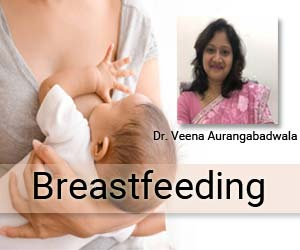- Home
- Editorial
- News
- Practice Guidelines
- Anesthesiology Guidelines
- Cancer Guidelines
- Cardiac Sciences Guidelines
- Critical Care Guidelines
- Dentistry Guidelines
- Dermatology Guidelines
- Diabetes and Endo Guidelines
- Diagnostics Guidelines
- ENT Guidelines
- Featured Practice Guidelines
- Gastroenterology Guidelines
- Geriatrics Guidelines
- Medicine Guidelines
- Nephrology Guidelines
- Neurosciences Guidelines
- Obs and Gynae Guidelines
- Ophthalmology Guidelines
- Orthopaedics Guidelines
- Paediatrics Guidelines
- Psychiatry Guidelines
- Pulmonology Guidelines
- Radiology Guidelines
- Surgery Guidelines
- Urology Guidelines
World Breastfeeding Week Special: Exclusive breastfeeding reduces risk of childhood obesity- Dr Veena Aurangabadwala

Breastfeeding is the most nutritious, natural, economical and least contaminated food that a new mother can provide to her newborn. It is a rich source of essential amino acids, fats, carbohydrates, vitamins and minerals, and water, that is more than enough to sustain the newborn's needs in the first 6 months of life. It helps provide the baby with essential immunoglobulins, which provide protection from infections as well as chronic diseases. Retrospective studies have revealed that individuals who were breastfed in childhood, had better IQs.
Exclusive breastfeeding reduces the risk of overfeeding and thereby reduces the incidence of childhood obesity.
Besides the baby, it also gives several benefits to the mother. It is definitely the most convenient option for a new mother, as breastmilk doesn’t have to be prepared and stored in sterile containers. Breastfeeding also helps her get back to pre-pregnancy weight faster. It also has some natural contraceptive action, though not complete. Overall, it greatly helps mother and child bonding. Studies also reveal the women who have breastfed are at a lower risk of developing cervical cancer compared to those who have never breastfed in their lifetime.
The IAP and FOGSI recommend 6 months of exclusive breastfeeding, which means feeding only breastmilk to the baby for the first 6 months of its life. On average, women continue to breastfeed their children for 2-3 years. Working women can also continue to give the benefits of breastfeeds to their babies, while they’re away at work, by learning the techniques, of breastmilk pumping and storage. Manual and electric breast pumps, as well as milk storage bags and bottles, are now commercially freely available.
But not every woman is able to get breastmilk that is adequate for her baby. This is the very reason that breast milk banks have been established where, women having excess breastmilk could donate some amounts, so that other babies could get the benefits of breastmilk.
Pregnancy is probably the first time in her life, that a woman visits a doctor or gets her breasts examined by a medical professional. It is, therefore, extremely important for successful breastfeeding, to have a breast examination done at the first antenatal visit. It helps identify physiological variations such as inverted, retracted, flat nipples, as well as pathological conditions such as fibroadenomas, cysts and even malignancies of the breast. Once these are identified, it allows enough time to take corrective steps, well before delivery so as to avoid surprises and difficulties in breastfeeding immediately after the baby is born.
Common variations noticed in pregnant women are flat nipples, inverted nipples, hard areolae. There are commercially available nipple formers that could be used after the 8th month of gestation, to improve these conditions, before the baby is born.
Recognising the advantages of breastfeeding, especially in countries where malnutrition was the biggest cause of child morbidity and mortality, the Baby-Friendly Hospital Initiative is a global program that was launched by the World Health Organization (WHO) and the United Nations Children's Fund (UNICEF) in 1991 to encourage and recognize hospitals and birthing centers to offer an optimal level of care for infant feeding and mother/baby bonding. This initiative highlights ten useful points that each birthing center should comply with that helps to establish successful breastfeeding. Breastfeeding on demand, rooming in the baby with the mother, initiating breastfeeding within the first hour of birth (golden hour), and establishing breastfeeding support groups are some of the salient features of this initiative.
Dr. Veena Aurangabadwala is a Consultant Obstetrics and Gynaecologist at Zen Multispeciality Hospital, Chembur.

Disclaimer: This site is primarily intended for healthcare professionals. Any content/information on this website does not replace the advice of medical and/or health professionals and should not be construed as medical/diagnostic advice/endorsement or prescription. Use of this site is subject to our terms of use, privacy policy, advertisement policy. © 2020 Minerva Medical Treatment Pvt Ltd